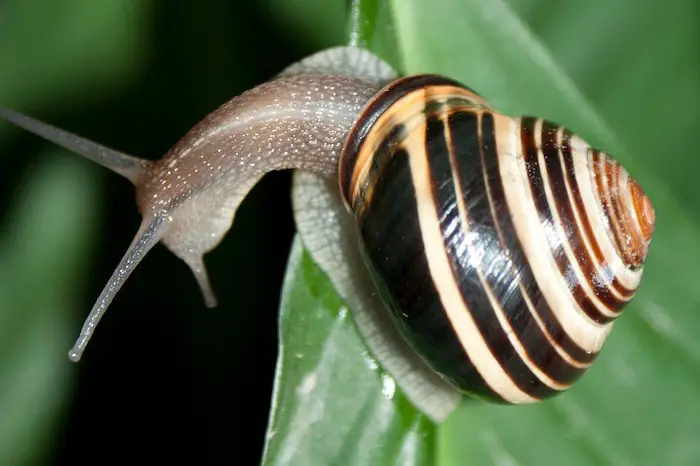Love them or hate them, but you can’t ignore them! These terrestrial mollusks glide on soil, plants, and barks of trees with their flat muscular foot. They retrace into a hard shell at the slightest threat. As per the ancient folklores, snails are the harbinger of changing seasons and gardens are incomplete without them.
If a black snail crosses your path, it suggests rains. When they climb trees, it indicates hot weather is arriving. When snails burrow into the ground, it indicates winter is around the corner. Although snails cause damage to plants and crops, they also help in cleaning the debris and adding nitrogen-rich fertilizer to the soil.
So, what’s the average lifespan of a garden snail? Most species are annuals, while others are known to have an average life expectancy of 2-3 years. There are some larger species like the Roman snails that can live in the wild habitat for 10-15 years or even longer. If a land snail is lucky and lives in a container, it may live as long as 25 years.
Most common garden snails (species: Helix aspersa) are air-breathing creatures having a single lung. They have a brownish body with slimy mucus and cream-colored exterior shells. Some species may have brown spiral stripes on the shells. They achieve the stage of adulthood and get ready to reproduce in about a year, sometimes even faster.
Each adult snail is capable of hatching more than 100 eggs in a lifetime. Most of them die even before hatching or a few days after their birth. Nearly 50% of the adults die each year but if the snails manage to reach adulthood, their chances at survival is much higher. You can tell that a garden snail is old, if it has a lip at the edge.
A few species like the large Roman snail take much longer (approximately 3 years) to become adult. However, like most other species with a high reproductive rate, a much smaller portion of the laid eggs to on to become snails. Even after they hatch, there are numerous threats from predators and gardeners who may want to get rid of them.
Size and Lifespan Of Common Garden Snails
It’s hard to put the different types of snails into an average life expectancy because they vary widely depending on their size and other aspects. Here’s some extensive information on the three common species of snails you can find:
Big Grey Snail
Also known as Gros Gris or Helix Aspersa Maxima, this species of snail was bred and presented in the 1978. At the time, when they were presented, it was possible to breed them only in spring and summer seasons. However, after ten generations and using a an advanced process of breeding, it is now possible to cultivate them in cold season too.
The Helix Aspersa Maxima, often referred to as the big grey snail is considered really popular for breeding. The climate of Ukrainian is also considered to be really favorable for the life of these snails. They usually weigh about 16-25 grams and the diameter shell is 40-45 mm. They are one of the largest mollusks found.
Grape snail
These species of snails are popular in the province of Burgundy and they thrive in the climate of Ukraine. They are typically grown on open farms and take about one to three years to achieve maturity. When they achieve adulthood, the shell measures about 40-45 mm in diameter and the weight is approximately 35 grams.
These burgundy snails look pretty and they thrive on green moss. In the wild habitat, the grape or burgundy snails may live for 8 years. However, they often die due to attack by predators.
Grey Small Snail
Known as Petit Gris or Helix Aspersa Muller, this grey small snail is the most commonly found garden snail. The adult species typically has a shell diameter ranging from 25 to 40 mm, and the height is approx 35 mm. Their weight is usually 6 to 10 grams.
Native to Europe, they were often known as the “European Brown Garden Snail”. The young snails usually take 1-2 years to achieve maturity. As they face numerous enemies and challenges during growth, their life expectancy is low.
The garden snail glides with the help of a flat muscular foot, and the motion is supported with the release of mucus to nullify the friction on the surface. Due to the release of mucus, they snails leave a trace behind when they move.
Factors That Impact The Average Lifespan Of A Garden Snail
There are several factors that impact and define the lifespan of a garden snail. Below, we have created a quick guide to help you understand the favorable habitat in which they thrive, what they feed on, their behavior and reproduction. These are the key factors that determine the lifespan of garden snails.
Favorable Natural Habitat
The snails are originally native to the Mediterranean region, however you can now find them in almost all areas of the world, except Antarctica. As a result, this is a widely distributed species. The ones belonging to the family of garden snails (species: Helix aspersa) can be found in lowlands of Western Europe, Great Britain, the Mediterranean, Iberian Peninsula, the Middle East, North Africa and Turkey.
They have an interesting history of distribution and it is believed that the snails came hidden in vegetables or plants in shipments to countries like Australia, Mexico, Argentina, New Zealand, Haiti, South Africa, Chile, and some islands in the Atlantic Ocean. Some were intentionally introduced to make the garden soil more fertile.
The gardens are known to live peacefully in regions that have a temperate climate, whether inhabited or not inhabited by humans. They usually thrive in the garden, meadows, forests, farmland, parks, and hedges.
Natural Behavior
The garden snails are terrestrial species that perform their daily activities at night or in wee hours of the morning. If it rains during the day, they will move out of their hiding places. Both in hot or drought times, the snails retract into their shell and seal the opening to retain the moisture and prevent animal attack.
After they retreat into the shell, they usually enter into a state of idleness that is similar to hibernation. However, it’s worth noting that there are a few snails like the one native to Southern California that do not hibernate and stay active throughout the year.
There are a few that hibernate only during winter months after they reach maturity and they return to their active stage in spring. This behavior protects them from predators and adds more years to their lifespan.
Eating Habits or Diet
As the garden snails are herbivorous, they consume different types of plant matter. They typically enjoy an organic diet comprising of fruits from the trees, cereals, flowers, herbs, and even bark of trees. At times, they may also add decomposed plants and animals to their diet.
As the snails often feed on fruits or flowers so painstakingly cultivated by gardeners or farmers, they are often considered as a trouble-making pest. Their mouth is located under the tentacles, and it comprises of a toothed ribbon known as radula that is used to breakdown the food.
Reproductive Cycle
The garden snails are hermaphrodite, which means both the male and female reproductive organs are present in one. They are capable of producing sperms and also eggs to be fertilized. However, it’s worth noting that they usually mate with another snail in order to produce reproductive cells.
Once hatched, a garden snail will achieve sexual maturity and capable of reproduction in between the first and second year of their life. The breeding season usually commences in early summer when the snails undergo the courtship period leading to mating. The entire mating process may last for about 4 to 12 hours.
During this period, the snails fertilize each other and after 3 to 6 days, they will lay approximately 80-90 eggs. Each snail borrows a hole in the ground and drops eggs in the nest about 1 to 1.5 inches deep in soil and the hatching occurs 2 weeks later (for summer season).
In one year, the garden snails are capable of producing maximum six batches of eggs, and the hatchlings will take about 1-2 years to achieve maturity and be able to reproduce again.
Top Predators Of Garden Snail
Despite an average life expectancy of 2-3 years, it’s worth noting that many garden snails do not live enough to mature and reproduce. As they are slow, defenseless, and vulnerable, their biggest threats are the numerous predators that belong to birds, mammals, small vertebrates, and invertebrates family.
As the garden snails belong to the bottom of the food chain in the eco-logy of earth, they become the food for bigger and faster animals. They are a source of food for lizards, frogs, worms, rats, mice, salamanders, blackbirds, turtles, beetles, nematodes, weasels, wild turkeys, and so on.
Sometimes the large snails (eg. Decollate snail) and other species of snails may even attack and eat the smaller and more vulnerable ones. They may even eat the eggs of slugs and snails. Certain species like Rumina conch enjoy feeding on their relative garden snails.
Different Ways In Which Snails Saves Their Lives
As mentioned above, garden snails are threatened by a lot of animals, birds, and even members of their own family. However, this does not mean that the garden snails are completely defenseless against them. There are several ways in which the vulnerable looking garden snail betrays, fools, or flees from predators. Let’s take a look at ways in which garden snails save their lives.
They retract into shells
The snails are known to carry their house at their back, into which they retract when they sense the slightest of threats. To defend against strong enemies, they hide within their hard shell covering and seal the opening with a mucus layer known as epiphragm.
They burrow into the ground
Despite being a lazy walker, the garden snails act quickly to save their life when they sense a predator nearby. They will hide or borrow beneath the ground, to disappear from the sight.
They dwell in hard to reach places
When the garden nails sense danger in the place where they live, they will make home in places where they can hide, such as under a rock or plant. They may even dwell in the gaps or cracks in the ceiling or other concrete structures in your garden.
They release mucus
When a garden snail is attacked by a predator, it quickly secretes a large amount of mucus substance to stifle and confuse the attacker. It is not confirmed whether these secretions contain toxic elements or not.
They run away
They are slow movers but when there’s danger around, they can move quite swiftly, especially when another snail is on top of them. Some will manage to flee even without the attacker noticing.
They camouflage with their shell
As the shell of snails are mostly light brown or slightly darker in shade, it gets hard to locate them on the ground or trunk of trees. This is often called cryptic coloring and it helps in fooling the predators.
Related Questions
Do garden snails have eyes
The mollusks are completely blind and have no ears either. Despite being devoid of the ability to see and hear, their sense of smell is extraordinary. They can easily locate food from a distance of a few meters, which is incredible for an animal of their size.
How many times do snails lay eggs in a year?
When the conditions are favorable, usually summer (warm temperature and high humidity), snails can sometimes reproduce as frequently as once in a month. They will mate and lay more eggs in months that have at least 10 hours of constant day light.
So, if a snail lays about 86 eggs in each cycle, and has about five reproductive cycles in one year, each snail can lay approximately 430 eggs in a year. Garden snails will typically reproduce in the second year of life, and they lose a lot of weight after laying eggs. Some snails recover and live more, while a few may die after the breeding season.
When do the snails stop and enter hibernation
The garden snails enter a hibernation period usually in winter. During this time, their metabolic rate drop and their heart rate and respiration also become slower. If hibernation sets in summer, the process is called estivation.
See Also:
What Do Garden Snails Eat?
How To Clean Garden Tools With Vinegar
A Zen Garden: All You Need To Know
4 Best Garden Hoses For Cold Weather Use


